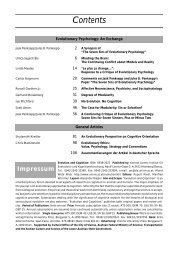Contents - Konrad Lorenz Institute
Contents - Konrad Lorenz Institute
Contents - Konrad Lorenz Institute
Create successful ePaper yourself
Turn your PDF publications into a flip-book with our unique Google optimized e-Paper software.
Was the First Craniate on the Road to Cognition<br />
cesses at work in both ontogenesis and evolution.<br />
Biologist Brian GOODWIN writes: “Developmental<br />
processes are hierarchical. So are biological classification<br />
schemes” (GOODWIN 1994, p234). Wallace<br />
ARTHUR agrees: “A theme running through the work<br />
of most contributors to what can now be described<br />
as evolutionary developmental biology is the relationship<br />
between these two hierarchies”, (ARTHUR<br />
1997, p256) and he asserts that “it is informative<br />
about the nature of evolutionary mechanisms”<br />
(p257).<br />
Saltation<br />
How much further back can we trace our ancestors<br />
Nicholas HOLLAND, for one, wants to know what preceded<br />
these complex, early Cambrian craniates, a<br />
question, he says, that remains as big a mystery as<br />
ever: “Where are Haikouella’s ancestors The sixtyfour<br />
dollar question is, What is this hooked to That<br />
nobody knows” (HOLLAND personal communication).<br />
In his presentation to an international symposium<br />
on Cambrian body plans (1999), HOLLAND<br />
gave genetic reasons why the most popular theoretical<br />
predecessor for chordates, tunicates (sea<br />
squirts), only works in the imagination of the theorists.<br />
When chordates are compared genetically<br />
with tunicates and fruit flies, he says, “the fruit fly is<br />
closer to the tunicate every time” (HOLLAND personal<br />
communication).<br />
No obviously ancestral fossils presently exist to<br />
support theories about how chordates, or the other<br />
phyla, evolved in Precambrian times. “There are a<br />
lot of different totally cutup paper doll ideas about<br />
where things come from that aren’t based on fossils<br />
at all, but people sitting in their armchairs”, says<br />
HOLLAND (personal communication). The ceaseless<br />
re-interpretation of ancestral lineages for the phyla<br />
is easily demonstrated by the relevant literature<br />
(ARTHUR 1997, p73; BERGSTRÖM 1994; LYNCH 1999).<br />
Wherever the first chordates came from, HOLLAND<br />
thinks science must now take seriously the concept<br />
of “saltation”, the possibility of evolution in quick<br />
jumps. However broadly one defines “saltation”, paleontological<br />
evidence for the notion is certainly<br />
supportive of the internalist/developmentalist position.<br />
Though opinions vary about the Precambrian antiquity<br />
of the phyla, all agree that almost all of these<br />
most widely separated animal groups had appeared<br />
by the early Cambrian period. Why didn’t new phyla<br />
continue to evolve during subsequent eras Why did<br />
Figure 3. Sponge embryos seen under the microscope at the<br />
cellular level in early cleaving stages, well preserved by the<br />
thousands from Precambrian deposit at Weng’an.<br />
such disparate phyla as chordates, mollusks, arthropods,<br />
and the 35-or-so others first show up in the fossil<br />
record so close to the same time CHEN places the<br />
window of opportunity for the explosive evolution<br />
of the majority of body plans within a narrow window<br />
of three million years (CHEN 1999), though of<br />
course, this is hotly disputed.<br />
Body plans seen in the Precambrian include<br />
sponges, annelid worms, and echinoderms (like sea<br />
stars), but little else to represent the many lineages<br />
expected to lead to the 35 Cambrian groups. Gradualists<br />
have claimed that the ancestors of the many<br />
other disparate Bauplans must have been too small<br />
or too soft to be preserved. But since 1998, phosphate<br />
deposits at a Precambrian locale called<br />
Weng’an have proved capable of preserving the<br />
smallest and softest organisms imaginable (LI et al.<br />
1998). Sponge embryos have been found by the<br />
thousands in early cleaving stages, seen under the<br />
microscope in groups of 2, 4, 8 cells, etc. (Figure 3).<br />
Though small and soft specimens are found in<br />
abundance, the number of body plans remains<br />
small.<br />
The questions raised by such findings drew sixty<br />
scientists to Kunming, China, for a symposium entitled:<br />
“The Origins of Animal Body Plans and Their<br />
Fossil Records”. Perhaps it took the discovery of our<br />
own phylum’s participation in the early Cambrian<br />
big bang to bring together such an international<br />
gathering to consider a pattern some call “top-down<br />
evolution”.<br />
Evolution and Cognition ❘ 147 ❘ 2003, Vol. 9, No. 2








